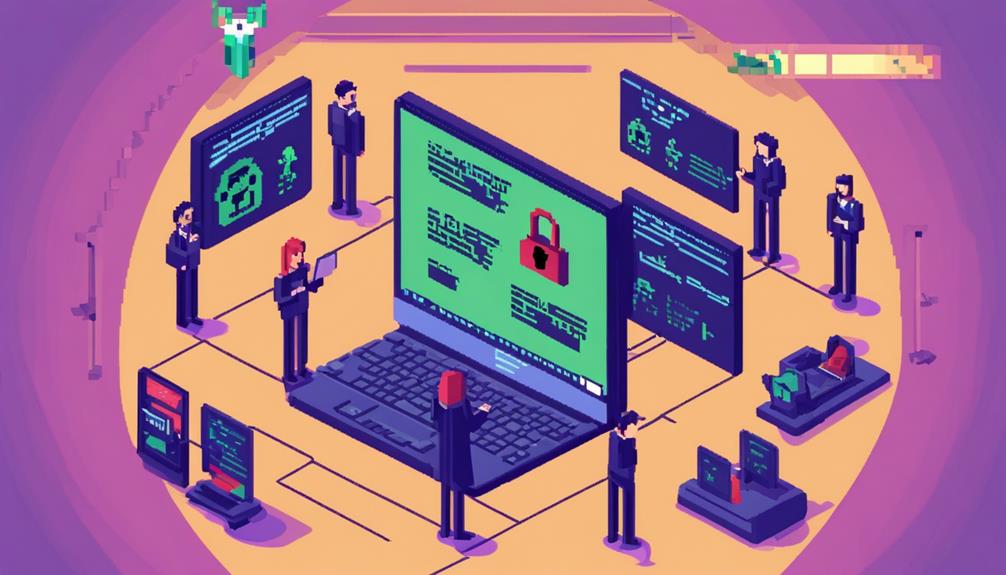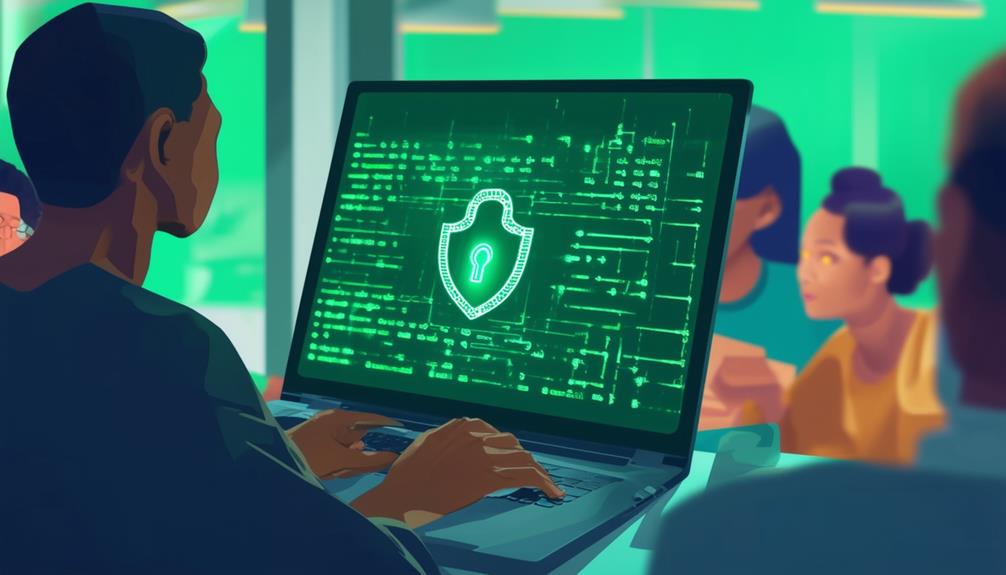While Incognito mode hides browsing history and cookies, it does not guarantee safety from hackers. Hackers can still pose a risk to your online security while using this mode. Incognito mode does not fully protect against malicious tracking, saved passwords, or public Wi-Fi vulnerabilities, leaving users exposed to potential attacks. To enhance protection, consider tools like VPNs, update antivirus software regularly, practice caution with passwords, and implement two-factor authentication. Understanding the limitations of Incognito mode can help users take additional steps to secure their online activities. Informed decisions regarding online security are essential in safeguarding against potential threats.
Key Takeaways
- Incognito mode does not protect from hackers monitoring online activities.
- Saved passwords and form data can still be vulnerable.
- Public Wi-Fi networks pose security risks.
- Malware can compromise data security.
- Additional encryption tools like VPNs are recommended for stronger protection.
What Incognito Mode Hides
Incognito mode effectively conceals browsing history, cookies, and site data from being stored on the device. This private browsing mode provides a layer of protection to users aiming to safeguard their data privacy.
By not saving form data, passwords, or searches during the browsing session, incognito mode guarantees that personal account information remains segregated and isolated from the regular browser functions. This feature is particularly useful for individuals who share or use public devices, as it helps reduce traces of online activities that would otherwise be stored in the browsing history.
In essence, incognito mode acts as a temporary shield for users, offering a level of anonymity by preventing the accumulation of browsing data on the device. By concealing these elements, users can navigate the internet with a sense of enhanced privacy, knowing that their online actions are not being permanently recorded or stored.
Limitations of Incognito Mode

Incognito mode, while offering a level of privacy by not retaining browsing history or cookies, does not shield users from being tracked by websites, internet service providers, or malicious actors.
This means that even though your browsing history is not stored locally, information such as saved passwords and form data can still be at risk.
Additionally, using public Wi-Fi networks while in incognito mode can expose users to security vulnerabilities and potential attacks from hackers.
Tracking in Incognito
Despite its popular use for privacy, the limitations of browsing in incognito mode become evident when it comes to tracking online activities. Incognito mode does not provide full protection against tracking by cybercriminals, who can employ sophisticated techniques to monitor users even in private browsing sessions. Hackers have the capability to capture screenshots, log keystrokes, and track visited websites, bypassing the privacy features of incognito mode. This highlights the vulnerabilities of relying solely on incognito mode to shield online activities from tracking and surveillance.
| Tracking Limitations in Incognito Mode | ||
|---|---|---|
| 1. Does not protect against sophisticated hacking techniques | ||
| 2. Malware can compromise security | ||
| 3. Hackers can monitor online activities | ||
| 4. Capable of capturing screenshots and logging keystrokes | ||
| 5. Possible for hackers to check visited websites |
Saved Data Risks
When utilizing private browsing sessions, users should be aware of the risks associated with saved data in incognito mode. Despite the perception of increased privacy, incognito mode does not fully protect against saving personal information or online activities.
Saved data risks remain a concern as malware can still compromise security and access sensitive information. Hackers possess the ability to monitor online activities, capture screenshots, log keystrokes, and potentially check visited websites even when incognito mode is active. This means that your personal information may still be at risk of exposure, highlighting the limitations of relying solely on incognito mode for privacy protection.
To mitigate these risks, users should consider additional security measures like using VPNs to bolster their online privacy and safeguard against potential threats from hackers who can exploit vulnerabilities even in private browsing sessions.
Public Wi-Fi Concerns
Given the inherent risks associated with saved data in incognito mode, it is imperative to address the limitations of relying solely on this browsing feature when connecting to public Wi-Fi networks. Public Wi-Fi networks pose significant security concerns as hackers can easily intercept data transmissions, even when users are in incognito mode. Despite the misconception that incognito mode provides complete anonymity, it does not safeguard against malicious actors exploiting vulnerabilities in public Wi-Fi setups.
Hackers have the capability to monitor online activities and potentially access sensitive information, rendering incognito mode insufficient for thorough protection in such environments. It is advisable to exercise caution when using public Wi-Fi networks, refraining from accessing sensitive accounts or transmitting confidential data.
To enhance security while connected to public Wi-Fi, individuals should consider utilizing a Virtual Private Network (VPN) as an additional layer of protection against potential cyber threats. Stay vigilant and prioritize safeguarding your data when traversing the digital landscape, especially when utilizing public Wi-Fi networks.
Privacy Risks in Incognito Mode

Incognito mode, despite its name, does not shield users entirely from privacy risks online. When browsing in this mode, individuals are still susceptible to tracking mechanisms that can compromise their security and data.
It's important to be aware that while incognito mode provides some level of privacy, it is not foolproof and users should exercise caution when engaging in sensitive activities online.
Tracking In Incognito
Utilizing private browsing mode does not guarantee protection against tracking and privacy risks inherent in online activities. While incognito mode prevents the storage of browsing history, cookies that websites use to track user behavior can still be active. These cookies allow websites to collect data on your preferences and activities, even in incognito mode, compromising the privacy benefits it offers.
Websites can utilize these tracking cookies to monitor your online movements, potentially exposing sensitive information to third parties. Despite the temporary nature of incognito mode, it does not shield users from the prying eyes of websites seeking to gather data for various purposes. Users should be cautious when relying solely on private browsing to safeguard their online activities.
To enhance protection against tracking in incognito mode, consider using additional tools like ad blockers and privacy-focused browser extensions. These tools can help mitigate the risks associated with tracking cookies and bolster your online privacy.
Security of Data
Enhancing data security while browsing in private mode requires additional measures to protect against potential privacy risks. Despite the perception of increased anonymity, using private browsing options such as Incognito mode does not guarantee complete protection against online threats. Malware can still breach the system, compromising data privacy even when in incognito mode.
Hackers possess the capability to employ sophisticated techniques, such as capturing screenshots, logging keystrokes, and monitoring online behavior, despite the use of private browsing. It is essential to recognize that private browsing alone does not prevent hackers from accessing visited websites or intercepting sensitive information during online sessions.
To fortify defenses against cyber threats, it is advisable to complement private browsing modes with additional security measures like encryption and VPN services. These supplementary tools can provide an added layer of safeguarding online privacy and enhance data protection while browsing in private mode.
Enhancing Incognito Mode Security

To bolster the security of online activities while using incognito mode, it is advisable to incorporate additional protective measures beyond the browser's built-in features. While incognito mode can help prevent your browsing history from being stored on your device, it does not hide your IP address, leaving it visible to potential hackers.
To enhance security and safeguard your online privacy, consider utilizing VPN services in conjunction with incognito mode. VPN services create a secure and encrypted connection to the internet, masking your IP address and making it harder for hackers to track your online activities.
Hacker Threats in Incognito Mode

Hacker threats pose significant risks even when browsing in incognito mode due to the limitations of its privacy features. Despite the assumption of anonymity, incognito mode does not shield users from sophisticated hacking techniques employed by cybercriminals. Malware remains a looming threat that can compromise security and gain access to sensitive information during private browsing sessions.
Hackers possess the capability to monitor online activities, capture screenshots, and log keystrokes, thereby jeopardizing the confidentiality of online interactions. Even in private browsing mode, hackers can bypass restrictions to check visited websites and track online behavior, emphasizing the vulnerabilities of incognito mode.
To fortify protection against such threats, it is advisable to implement additional security measures like Virtual Private Networks (VPNs) to encrypt internet traffic and enhance anonymity. Safeguarding online activities requires a thorough approach beyond relying solely on the limited privacy safeguards offered by private browsing modes.
Strengthening Incognito Mode Protection

When contemplating the security of browsing in incognito mode, it is vital to acknowledge the limitations in protecting against sophisticated hacking techniques. While incognito mode offers some level of privacy by not storing browsing history, it does not shield users from hackers who employ advanced methods to infiltrate systems.
Malware, for instance, can compromise the security of incognito mode, allowing hackers to access sensitive information. Moreover, hackers have the capability to monitor online activities even when in incognito mode, potentially capturing screenshots or logging keystrokes without the user's knowledge.
It is important to note that private browsing does not prevent hackers from checking visited websites or tracking online behavior. To strengthen the protection of incognito mode against hackers, users are advised to take into account additional security measures such as using encryption tools like Virtual Private Networks (VPNs).
Encryption adds an extra layer of security by encoding data transmitted over the internet, making it more challenging for hackers to intercept and exploit.
Safeguarding Against Hackers

Enhancing cybersecurity measures is essential to safeguarding against the threats posed by hackers when browsing online. When engaging in a private browsing session, it is important to implement additional protective measures to secure your online activities.
To enhance your cybersecurity posture and protect your online privacy, consider the following recommendations:
- Utilize encryption tools to secure your data transmission and prevent unauthorized access.
- Employ a reputable VPN service to mask your IP address and encrypt your internet connection.
- Regularly update your antivirus software to defend against malware that could compromise your browsing sessions.
- Be cautious of phishing attempts and refrain from clicking on suspicious links or providing personal information.
- Implement strong, unique passwords for each online account to minimize the risk of unauthorized access to your sensitive data.
Additional Security Measures

To further bolster online security and protect against potential threats, it is imperative to explore additional security measures beyond relying solely on incognito mode.
While private browsing offers a degree of anonymity, it is not foolproof against skilled hackers who can exploit vulnerabilities. Malware, keyloggers, and screenshot capturing techniques can still compromise sensitive information during incognito sessions.
To enhance protection, individuals should consider utilizing Virtual Private Networks (VPNs). VPNs encrypt internet traffic, making it considerably more challenging for hackers to intercept data or track online activities. By masking IP addresses and creating secure connections, VPNs add an extra layer of defense against cyber threats.
Combining the privacy features of incognito mode with the encryption capabilities of VPNs can substantially increase security when browsing the internet, particularly in scenarios where sensitive data is involved.
As cyber threats continue to evolve, implementing multiple security measures becomes essential in safeguarding personal information from potential breaches.
Comprehensive Online Protection

For a robust defense against cyber threats, achieving thorough online protection is paramount. To enhance your privacy and security online and safeguard against hackers, consider the following extensive measures:
- Implement strong and unique passwords for all your accounts to prevent unauthorized access.
- Regularly update your software and operating systems to patch vulnerabilities that hackers can exploit.
- Enable two-factor authentication for an added layer of security when logging into accounts.
- Be cautious of phishing attempts by verifying the authenticity of emails and avoiding clicking on suspicious links.
- Invest in reputable cybersecurity tools like antivirus software and firewalls to detect and prevent malicious activities on your devices.
Frequently Asked Questions
Can a Hacker See My Incognito?
Incognito mode does not guarantee protection against sophisticated hacking techniques. Hackers can potentially monitor activities, capture data, and access personal information even when using incognito mode. Additional security measures like VPN services are recommended for enhanced protection.
What Are the Risks of Incognito Mode?
When considering the risks of incognito mode, it is important to note that it does not offer extensive protection against cyber threats. Users should be cautious as sophisticated hacking techniques can compromise privacy.
Can Anyone See My Incognito History?
"Out of sight, out of mind" applies to incognito mode, but it doesn't guarantee privacy from hackers. While it hides browsing history, incognito mode isn't immune to surveillance. Enhance security with VPNs and cybersecurity best practices.
Does Incognito Spy on You?
Incognito mode does not spy on you, but it doesn't provide complete protection against hackers. They can still use advanced methods to track your online activities, compromising your security. Consider additional measures like using a VPN for enhanced protection.
Is There Anything Safer Than Incognito?
In the domain of privacy tools, some options offer enhanced security beyond incognito mode. While incognito provides basic protection, advanced measures like VPNs with military-grade encryption and multi-factor authentication offer heightened safety against cyber threats.
Conclusion
To sum up, although Incognito Mode offers some level of privacy protection, it is not completely safe from hackers. Users should be aware of the limitations and privacy risks associated with this feature and take additional security measures to safeguard against potential threats.
By enhancing the security of Incognito Mode and implementing thorough online protection, individuals can better protect their sensitive information from malicious actors.









